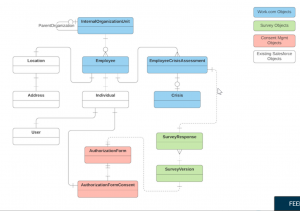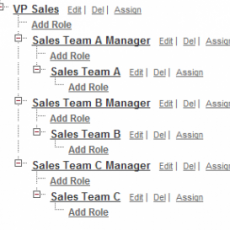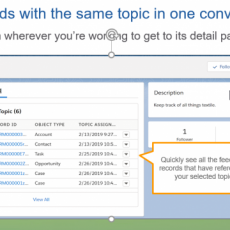If you are a manufacturer using Salesforce, with COVID 19, there is a need to safely open your factories, workplaces maintaining employee safety, and comply with state and county guidelines. One of the most recent features of Salesforce has been work.com with its features around tracking locations, contact tracing, and other features. So the question for most salesforce admins, CRM directors is the following questions.
- How can I use work.com for my company?
- If I end up using work.com and its features, what features of Salesforce will be impacted in my current org and how can I plan around it?
- How can I leverage my HR systems like Workday, PeopleSoft, Success Factors, and Salesforce effectively to enable my users to perform their jobs?
My post here will help you answer these questions and help you make the right decisions effectively.
How can I use work.com and how are other Manufacturers planning to use it?
For a typical manufacturer who is in discrete or process manufacturing, COVID 19 has been the driver to look for a solution to manage factory locations, shifts of their employees, mitigate risks with their factories meeting state guidelines. So here are some use cases on how it applies to manufacturing.
- Build trust with your partners by sharing locations of your factories and ensuring compliance.: Now most of your factory location data, shifts could be in your ERP or HR system. But if you have partner portals where you want to be transparent to your partners on your factory locations, bring the data to salesforce, and displaying it as a dashboard will enable more trust to your partner network.
- If you have employee portals in Salesforce, one of the challenges for employees is to see how Safe their locations are. Leveraging surveys from employees and sharing COVID 19 data of your locations will ease your employee’s fears and build trust.
- With the latest contact tracing module of salesforce, if your sales team logs meetings in person with the leads and contacts of your customers and in the scenario of the sales team member turning positive, contact tracing network graphs can help to visualize the impact in your locations.
If I end up using work.com and its features, what features of Salesforce will be impacted in my current org and how can I plan around it?
Org strategy
- Keep in mind work.com with Salesforce health cloud is an independent salesforce org that will stand out by itself as a separate org.
-
When keeping orgs in synch, avoid using bi-directional synchronization, as manual conflict management between org data will be required. Instead, I recommend having a single “source of truth” org. If a data change occurs in a different org, use Salesforce APIs to make the change in the “source of truth” org first, and then synchronize the change back to the org where the change initially occurred.
3. If other orgs only need read-only access to Work.com org data, use Salesforce Connect to display the Work.com org data in the other orgs.
4. If Salesforce Connect won’t work for your scenario, you can use Salesforce API calls to query the Work.com org. For example, you could use on-demand API calls in your Lightning Web Components to query your Work.com org data and display the data in your component.
5. Here are some things to consider to keep the data in sync between orgs. Consider doing initial data synchs followed by smaller incremental data synchs. A strategy might work as follows:
- Run an initial data load job to move data to the new org.
- Run nightly or hourly incremental data load jobs to keep orgs in synch.
- If a record is updated in the new org, use Salesforce APIs to update the existing org first, and then migrate that incremental change back to the new org. This avoids unnecessary data conflicts.
Data Impact.
-
- Work.com comes with the following major objects
- Employee
- Individual
- Location
- Person object
- Internal organization unit
- Here is a sample data model of the major work.com objects involved.

- Create a process that synchronizes Employee data with your org employee data. This synchronization has to be done on an ongoing basis for any new and changed records. You may also have to keep some amount of duplicate data between Employee records and solution data. Out of the box, work.com leverages an employee number field but you can use a unique id to keep the data in sync.
- Individual object is the junction object which can be used to link employee object to your other objects like person accounts or any custom object which you use to store employee data.
- here are examples for utilizing Individual’s connection to Work.com include:
- Solutions leveraging User can tie back via User > Individual < Employee.
- Solutions leveraging Contact can tie back via Contact > Individual < Employee.
- Solutions leveraging PersonAccount can tie back via PersonAccount > Individual < Employee.
- Solutions leveraging custom Employee objects can tie back via Employee > Individual < Custom employee object.
7. Location data is used by Work.com to associate Employees to physical locations. If you account for hierarchy or custom objects to track locations, you will need a sync process to sync work.com with existing locations.
8. The location object uses hierarchies to store multiple levels of data. Here is an example of a query that you would need to get the location data.
SELECT Id, Name, wkcc__LocationPath__c FROM Location WHERE wkcc__LocationPath__c LIKE '1314R000000PZ0eQAG:1314R000000PZ0jQAG:%'
Schema.Location parentLoc = [SELECT Id, wkcc__LocationPath__c FROM Location WHERE LocationLevel = 2 LIMIT 1]; String parentLikeClause = parentLoc.wkcc__LocationPath__c + ':%'; List<Schema.Location> locs = [SELECT Id, Name, wkcc__LocationPath__c FROM Location WHERE wkcc__LocationPath__c LIKE :parentLikeClause];9. Internal organization unit is another major object which stores your organization data. Typically this object is seldom used by companies or you might have an account with contacts associated with your org. You will need a syncing strategy to sync the internal organization unit with your accounts or create the records if you do not have one.
10. You also need to consider the impact of summary fields like wellness fact and other fields that need to architected carefully to effectively leverage them.
11. Work.com comes with out of the box triggers which needs to be reviewed and enabled upon review. When Work.com triggers are enabled, bulk operations on affected Work.com objects may incur additional limits. For EmployeeCrisisAssessment, batch sizes should be limited to 3000 records. For Location, batch sizes should be limited to 4000 records.
12. If you enable contact tracing, you would need to use person accounts on the org. This would mean that you would need to associate one time data load to keep the person accounts in sync with your existing accounts and contacts and a plan to keep them sync on an ongoing basis.
Security Impact
If Work.com has been installed in a new, dedicated org, but your org must access the original org, you need a strategy for authenticating to the other org.The following are recommended strategies for authenticating to another org.
1. Use the existing, original org as an identity provider. Use user authentication from the original org to log in to the Work.com org. Avoid creating replicated logins in the new Work.com org.
2. If the existing org is already using a different identity provider, you can either connect the Work.com org to the same identity provider or connect the Work.com org to the existing org.
3. Plan to create permission sets on your existing org to manage work.com object access to meet your compliance needs.
4. If you have a need to monitor tasks on the work.com org, leveraging sharing rules or role hierarchy, tasks can be shared with other users in the org. You can also use queues to track users.
HR System integration impactAs part of work.com implementation, there will be a need to have an integration strategy to integrate work.com with your HR system like Workday, People Soft, etc. Here are some guidelines which you can consider for it.1. Before you consider an integration, identify with your HR team on what stage of the business process in HR will be integrated with work.com like recruiting, onboarding, developing, retaining, and offboarding employees.2. Have an integration strategy to sync data between salesforce user, employee, individual, and employee object to your HR objects.3. Leverage the HR system’s unique id as a key for employee numbers to enforce data integrity.ERP -SAP Integration impact
- Work.com comes with the following major objects
If you are using SAP as your ERP system, here are some areas which you would need to consider as potential impacts.
- Have an integration strategy to sync Ship to data in SAP to Internal organization unit in work.com to track organization units.
- If you have to leverage contact tracing, Sold to data in SAP has to be also synced to the Internal organizational unit.
- For those who leverage account hierarchies to track internal organization data and customer accounts, have a strategy to flatten the hierarchy levels to fit the hierarchy needs of location and internal organizational units.
To summarize, here are the key takeaways when you plan to implement work.com in your org.
- Have an Org Strategy for syncing data between your org and work.com org
- Create an integration document for mapping out work.com objects to your org objects.
- Plan for synchronization of data between work.com and HR systems with a business process impact.
- If you leverage contact tracing, keep in mind that you will need to have person accounts enabled.
- Have a strategy for security which will have single sign-on, data sharing as key principles.
As always feel free to post your comments or send me an email to buyan@eigenx.com on a work.com readiness kit. My readiness kit will help you on the following
- Identify areas in your org for quick impact analysis.
- Document security impacts
- Map out integration impact in your org.
- Help you with a quick estimate of the project.
Please subscribe
Subscribe to our mailing list and get tips to maximize salesforce to your email inbox.
I am honored to have your subscription. Stay tuned for tips to maximize your salesforce investment
Something went wrong.




